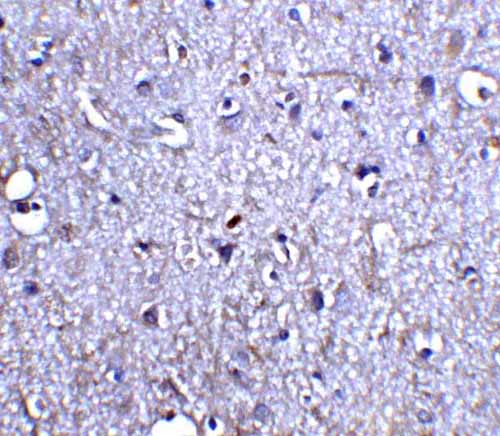QSOX1 Antibody
- SPECIFICATION
- CITATIONS
- PROTOCOLS
- BACKGROUND

Application
| WB, IHC-P, IF, E |
|---|---|
| Primary Accession | O00391 |
| Other Accession | NP_002817, 5768 |
| Reactivity | Human, Mouse |
| Host | Rabbit |
| Clonality | Polyclonal |
| Isotype | IgG |
| Calculated MW | Predicted: 65, 82 kDa; Observed: 66 kDa |
| Application Notes | QSOX1 antibody can be used for detection of QSOX1 by Western blot at 1 - 2 μg/mL. Antibody can also be used for immunohistochemistry starting at 5 μg/mL. For immunofluorescence start at 20 μg/mL. |
| Gene ID | 5768 |
|---|---|
| Target/Specificity | QSOX1 antibody was raised against a 17 amino acid peptide near the center of human QSOX1. The immunogen is located within amino acids 360 - 410 of QSOX1. |
| Reconstitution & Storage | QSOX1 antibody can be stored at 4℃ for three months and -20℃, stable for up to one year. |
| Precautions | QSOX1 Antibody is for research use only and not for use in diagnostic or therapeutic procedures. |
| Name | QSOX1 |
|---|---|
| Synonyms | QSCN6 {ECO:0000303|PubMed:9878249} |
| Function | Catalyzes the oxidation of sulfhydryl groups in peptide and protein thiols to disulfides with the reduction of oxygen to hydrogen peroxide (PubMed:17331072, PubMed:18393449, PubMed:23704371, PubMed:30367560, PubMed:23867277). Plays a role in disulfide bond formation in a variety of extracellular proteins (PubMed:17331072, PubMed:30367560, PubMed:22801504, PubMed:23867277). In fibroblasts, required for normal incorporation of laminin into the extracellular matrix, and thereby for normal cell-cell adhesion and cell migration (PubMed:23704371, PubMed:30367560, PubMed:23867277). |
| Cellular Location | [Isoform 1]: Golgi apparatus membrane; Single-pass membrane protein. Secreted. Note=A small proportion is secreted, probably via a proteolytic cleavage that removes the membrane anchor |
| Tissue Location | Expressed in heart, placenta, lung, liver, skeletal muscle, pancreas and very weakly in brain and kidney {ECO:0000269|PubMed:10708601, ECO:0000269|Ref.8} |

Thousands of laboratories across the world have published research that depended on the performance of antibodies from Abcepta to advance their research. Check out links to articles that cite our products in major peer-reviewed journals, organized by research category.
info@abcepta.com, and receive a free "I Love Antibodies" mug.
Provided below are standard protocols that you may find useful for product applications.
Background
The QSOX1 gene, also known as Quiescin Q6, is a fusion of two ancient genes: thioredoxin and ERV1. Its expression is induced as fibroblasts begin to exit the proliferative cycle and enter quiescence, suggesting that this gene plays an important role in growth regulation (1). The QSOX1 protein oxidizes sulfhydryl groups to form disulfide bonds in proteins. QSOX1 expression is induced by hypoxia (2) and appears to protect cells against oxidative stress-induced apoptosis (3).
References
Coppock DL, Cina-Poppe D, and Gilleran S. The quiescin Q6 gene (QSCN6) is a fusion of two ancient gene families: thioredoxin and ERV1. Genomics 1998; 54:460-8.
Shi CY, Fan Y, Liu B, et al. HIF1 contributes to hypoxia-induced pancreatic cancer cells invasion via promoting QSOX1 expression. Cell Physiol. Biochem. 2013; 32:561-8.
Morel C, Adami P, Musard JF, et al. Involvement of sulfhydryl oxidase QSOX1 in the protection of cells against oxidative stress-induced apoptosis. Exp. Cell Res. 2007; 313:3971-82.
If you have used an Abcepta product and would like to share how it has performed, please click on the "Submit Review" button and provide the requested information. Our staff will examine and post your review and contact you if needed.
If you have any additional inquiries please email technical services at tech@abcepta.com.













 Foundational characteristics of cancer include proliferation, angiogenesis, migration, evasion of apoptosis, and cellular immortality. Find key markers for these cellular processes and antibodies to detect them.
Foundational characteristics of cancer include proliferation, angiogenesis, migration, evasion of apoptosis, and cellular immortality. Find key markers for these cellular processes and antibodies to detect them. The SUMOplot™ Analysis Program predicts and scores sumoylation sites in your protein. SUMOylation is a post-translational modification involved in various cellular processes, such as nuclear-cytosolic transport, transcriptional regulation, apoptosis, protein stability, response to stress, and progression through the cell cycle.
The SUMOplot™ Analysis Program predicts and scores sumoylation sites in your protein. SUMOylation is a post-translational modification involved in various cellular processes, such as nuclear-cytosolic transport, transcriptional regulation, apoptosis, protein stability, response to stress, and progression through the cell cycle. The Autophagy Receptor Motif Plotter predicts and scores autophagy receptor binding sites in your protein. Identifying proteins connected to this pathway is critical to understanding the role of autophagy in physiological as well as pathological processes such as development, differentiation, neurodegenerative diseases, stress, infection, and cancer.
The Autophagy Receptor Motif Plotter predicts and scores autophagy receptor binding sites in your protein. Identifying proteins connected to this pathway is critical to understanding the role of autophagy in physiological as well as pathological processes such as development, differentiation, neurodegenerative diseases, stress, infection, and cancer.


